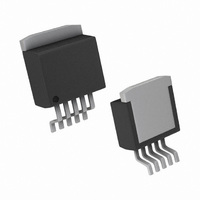LP3872ESX-3.3/NOPB National Semiconductor, LP3872ESX-3.3/NOPB Datasheet - Page 11

LP3872ESX-3.3/NOPB
Manufacturer Part Number
LP3872ESX-3.3/NOPB
Description
IC REG LDO 1.5A 3.3V TO-263-5
Manufacturer
National Semiconductor
Datasheet
1.LP3872EMP-3.3NOPB.pdf
(18 pages)
Specifications of LP3872ESX-3.3/NOPB
Regulator Topology
Positive Fixed
Voltage - Output
3.3V
Voltage - Input
Up to 7V
Voltage - Dropout (typical)
0.38V @ 1.5A
Number Of Regulators
1
Current - Output
1.5A (Max)
Operating Temperature
-40°C ~ 125°C
Mounting Type
Surface Mount
Package / Case
TO-263-5, D²Pak (5 leads + Tab), TO-263BA
Lead Free Status / RoHS Status
Lead free / RoHS Compliant
Current - Limit (min)
-
Other names
LP3872ESX-3.3
Available stocks
Company
Part Number
Manufacturer
Quantity
Price
Company:
Part Number:
LP3872ESX-3.3/NOPB
Manufacturer:
TI
Quantity:
12 000
Application Hints
EXTERNAL CAPACITORS
Like any low-dropout regulator, external capacitors are re-
quired to assure stability. These capacitors must be correctly
selected for proper performance.
INPUT CAPACITOR: An input capacitor of at least 10µF is
required. Ceramic Ceramic, Tantalum, or Electrolytic capaci-
tors may be used, and capacitance may be increased with-
out limit
OUTPUT CAPACITOR: An output capacitor is required for
loop stability. It must be located less than 1 cm from the
device and connected directly to the output and ground pins
using traces which have no other currents flowing through
them (see PCB Layout section).
The minimum value of output capacitance that can be used
for stable full-load operation is 10µF, but it may be increased
without limit. The output capacitor must have an ESR value
as shown in the stable region of the curve below. Tantalum
capacitors are recommended for the output capacitor.
SELECTING A CAPACITOR
It is important to note that capacitance tolerance and varia-
tion with temperature must be taken into consideration when
selecting a capacitor so that the minimum required amount
of capacitance is provided over the full operating tempera-
ture range. In general, a good Tantalum capacitor will show
very little capacitance variation with temperature, but a ce-
ramic may not be as good (depending on dielectric type).
Aluminum electrolytics also typically have large temperature
variation of capacitance value.
Equally important to consider is a capacitor’s ESR change
with temperature: this is not an issue with ceramics, as their
ESR is extremely low. However, it is very important in Tan-
talum and aluminum electrolytic capacitors. Both show in-
creasing ESR at colder temperatures, but the increase in
aluminum electrolytic capacitors is so severe they may not
be feasible for some applications (see Capacitor Character-
istics Section).
CAPACITOR CHARACTERISTICS
CERAMIC: For values of capacitance in the 10 to 100 µF
range, ceramics are usually larger and more costly than
tantalums but give superior AC performance for bypassing
high frequency noise because of very low ESR (typically less
ESR Curve
20063370
11
than 10 mΩ). However, some dielectric types do not have
good capacitance characteristics as a function of voltage
and temperature.
Z5U and Y5V dielectric ceramics have capacitance that
drops severely with applied voltage. A typical Z5U or Y5V
capacitor can lose 60% of its rated capacitance with half of
the rated voltage applied to it. The Z5U and Y5V also exhibit
a severe temperature effect, losing more than 50% of nomi-
nal capacitance at high and low limits of the temperature
range.
X7R and X5R dielectric ceramic capacitors are strongly rec-
ommended if ceramics are used, as they typically maintain a
capacitance range within
ing ratings of temperature and voltage. Of course, they are
typically larger and more costly than Z5U/Y5U types for a
given voltage and capacitance.
TANTALUM: Solid Tantalum capacitors are recommended
for use on the output because their typical ESR is very close
to the ideal value required for loop compensation. They also
work well as input capacitors if selected to meet the ESR
requirements previously listed.
Tantalums also have good temperature stability: a good
quality Tantalum will typically show a capacitance value that
varies less than 10-15% across the full temperature range of
125˚C to −40˚C. ESR will vary only about 2X going from the
high to low temperature limits.
The increasing ESR at lower temperatures can cause oscil-
lations when marginal quality capacitors are used (if the ESR
of the capacitor is near the upper limit of the stability range at
room temperature).
ALUMINUM: This capacitor type offers the most capaci-
tance for the money. The disadvantages are that they are
larger in physical size, not widely available in surface mount,
and have poor AC performance (especially at higher fre-
quencies) due to higher ESR and ESL.
Compared by size, the ESR of an aluminum electrolytic is
higher than either Tantalum or ceramic, and it also varies
greatly with temperature. A typical aluminum electrolytic can
exhibit an ESR increase of as much as 50X when going from
25˚C down to −40˚C.
It should also be noted that many aluminum electrolytics only
specify impedance at a frequency of 120 Hz, which indicates
they have poor high frequency performance. Only aluminum
electrolytics that have an impedance specified at a higher
frequency (between 20 kHz and 100 kHz) should be used for
the LP387X. Derating must be applied to the manufacturer’s
ESR specification, since it is typically only valid at room
temperature.
Any applications using aluminum electrolytics should be
thoroughly tested at the lowest ambient operating tempera-
ture where ESR is maximum.
TURN-ON CHARACTERISTICS FOR OUTPUT
VOLTAGES PROGRAMMED TO 2.0V OR BELOW
As Vin increases during start-up, the regulator output will
track the input until Vin reaches the minimum operating
voltage (typically about 2.2V). For output voltages pro-
grammed to 2.0V or below, the regulator output may mo-
mentarily exceed its programmed output voltage during start
up. Outputs programmed to voltages above 2.0V are not
affected by this behavior.
±
20% of nominal over full operat-
www.national.com










